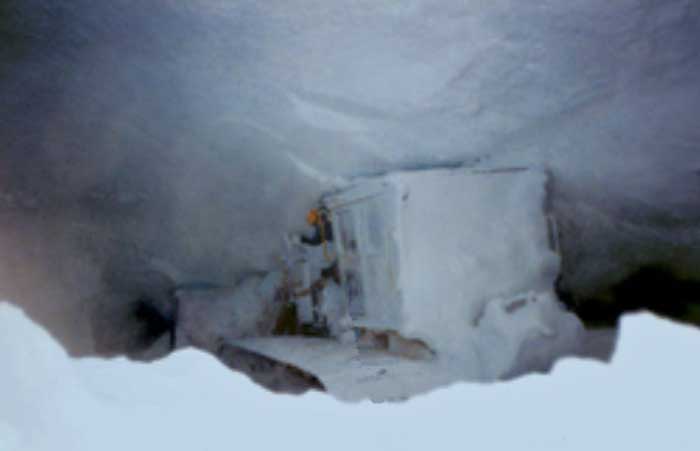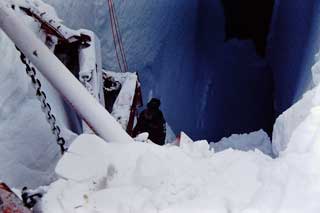The Demise of Linda
|
So what happened here? Well, a joint American/New Zealand seismic project titled SERIS was underway, led by principal investigators Uri ten Brink of Stanford and Tim Stern of DSIR (Wellington). It would run an 83-mile seismic profile line through the toe of the Robb Glacier (~20 miles SE of the Nimrod Glacier toe and ~90 miles northwest of the Beardmore) from the Ross Ice Shelf up to the Lowery Glacier (project maps and a link to more information). This project required a large quantity of explosives--well, about 25,000 lbs or 21 metric tons/tonnes of dynamite. So...accordingly, a 3-vehicle train, led by a Sno-Cat along with two LGP-D-8 tractors, was loaded up in McMurdo. It would head out on 21 November 1990, the day before Thanksgiving. | |
 The yellow (Kiwi?) supply sled. From left, Jules Uberuaga, Q the blaster (Quentin Rhoton), somebody in a red parka (!), and Russ Magsig (PL). The tractor train headed east and south out of McMurdo, through an area which had been previously been crossed by D-8's. Quentin Rhoton (Q) was driving Linda; he had just switched off with co-driver Brian Wheater who was with him in the cab. Leading the caravan was a four-tracked Tucker Sno-Cat driven by a Kiwi mountaineer; it was carrying food, survival gear, and the blasting caps. Interestingly, Brian had never heard of the Shear Zone before they discovered it first hand. From here we'll let Q narrate: "I was driving the Low Ground Pressure Caterpillar D8 (LPG-D8) bulldozer, towing a heavy sled and a lighter sled. We were following a Sno-Cat and traveling at about 4 km/hr. The surface was white snow for miles around; we could see no relief. Brian Wheater, my co-driver, remarked that the leading Sno-Cat had disappeared! (We learned later that it had driven over a small hill ahead of us). A short moment later, we rode up this unseen small slope. "Then 'gravity struck.' Actually gravity was the only force acting on us. The right-front end of the dozer went in first. I throttled down and shifted out of gear as the tractor tipped nose down and plummeted vertically downward. "The dozer blade scraped snow and ice off of the crevasse wall on the descent. Soon the roof of the cab was also scraping snow and ice from the far wall of the crevasse. Shattered glass from the cab windows and snow streamed into the cab as we fell. Both of us concentrated on trying to stay in the cab. "Then we stopped falling. The dozer was front-end down. We stood on the windowsill. 'What's going on?' 'Where are the sleds that we were towing?' The engine was still running, we could feel the warmth of the rising exhaust and also could smell the fumes. I turned off the engine. We did not want to be asphyxiated nor did we want the heat to melt ice or snow and upset our precarious position." [This happened only 27 miles from McMurdo. Below, a marked-up aerial photo (W&M) (note that north is to the left):] Q's narration continues: "We inched along the windowsill until we could look up behind us. There was the big steel sled, skis awry, wedged across the top of the crevasse. We knew it contained 16 tonnes of cargo. It was still connected to us. 'Was it holding us up?' 'Was it about to fall?' We were definitely not going to test these questions by trying to climb up the tow line. We decided to stay still, relax a little, and wait for rescue. We were unhurt. "Some light was entering the hole that the fall had made in the crevasse bridge. We looked around. The sides of the crevasse were nearly vertical, smooth and sheer; there were no handholds or footholds. The width of the crevasse tapered downward and to the left. If we had traveled 2m to the right, we would have fallen into a wider and deeper portion of the crevasse and would not be telling this story to you now. "The engine began to cool. The contracting metal made snapping sounds that echoed eerily in the crevasse. "We used a walkie-talkie radio to speak with the other members of the group. They were on the surface and were fine. The batteries became cold and the radio stopped working. "After 45 min, some of our friends [including Russ Magsig, who had been driving Pam] had crawled, very gingerly for fear of falling in themselves, to the top of our crevasse and called down to us. The big radio was in the small sled that we had been pulling. They were able to set it up and call for help." [About this time, Q kicked at the snow and hit the military thermos they had filled with coffee. It was still hot. Also about this time, a beeper alert went out in McMurdo for the search-and-rescue (SAR) team. USAP employee Jeff Thompson responded after first asking "is this a drill? It wasn't. He and other members of the SAR team collected their gear and gathered at the helo pad. Mary Ann Waters, a Kiwi from Scott Base, was the SAR team leader...other members of the six-person team included Brooks Montgomery, the lead USAP outdoor survival instructor. (Sam Williams and Kiwi Garth Varcoe were also involved at some point in the rescue or recovery.) The team boarded a VXE-6 Huey-N helicopter and were transported to the accident scene. Upon arrival, they set deadman anchors so they could safely rope up and approach the crevasse...not the only one in the area.] "Brian and I talked about our lives up until now, especially about prior dramatic adventures and for- mer wives and girlfriends. What else could we do? We heard helicopters. Nothing happened to us. We wondered what they were doing up top. It was taking a long time. Have they opened our food boxes to have a party up there? [Mary Ann Waters descended 72 feet down to the men trapped in Linda's cab. It took more than 3 hours to safely recover first Q and then Brian.] "After 3-1/2 hr, ropes were lowered. Mary Ann, one of the ice and safety experts, came down. She said that we 'look in reasonable shape.' What is reasonable? We were cold and suffering from minor frostbite." "A helicopter took us away. We were inspected by a doctor and told to take a day off work." Another account of this event appeared in the front matter of the October 1991 annual review issue of the Antarctic Journal: Despite safety precautions, work in Antarctica continues to be hazardous. No single event during 1990-1991 emphasized this fact more than a Thanksgiving eve accident 44 kilometers (27 miles) from McMurdo Station. On 21 November, two employees of NSF's support contractor were transporting 11,340 kilograms (25,000 pounds) of dynamite, destined for a seismic investigation on the Ross Ice Shelf, on a D-8 bulldozer across the ice shelf. Traveling over an area used previously by D-8s, the 41,000-kilogram (90,000-pound) bulldozer suddenly broke through a snow-bridged crevasse, plunging 15 meters (50 feet) down into the crevasse before its blade halted its descent. The men, trapped in the D-8, watched for more than 3 hours as the sled with the explosives hung precariously above them. Within an hour of the accident, the U.S./New Zealand search-and-rescue (SAR) team was organized and transported to the site by helicopter. Finally, the SAR team leader was lowered into the crevasse and attached rescue harnesses to the two men. All three were successfully hoisted to safety, and the men were flown immediately to McMurdo Station for minor medical treatment. During the next 2 weeks, U.S. Antarctic Program (USAP) contractor employees, U.S. Navy personnel, and New Zealanders from Scott Base worked together to retrieve the dynamite. Although this effort was successful, they were unable to recover the vehicle. No photos were taken (so far as I know) during the rescue. But folks returned the day after Thanksgiving to recover things...and many photos were taken then. | |
|
The loaded dynamite sled, partially in the crevasse (JT). |
Getting ready to unload the sled, with help from Pam (JT). |
 A closer look along the horizontal extent of the crevasse (JT). |
|
 A last look at Linda. If you compare the top background of this photo to the bottom of the crevasse photos just above, you'll discern the location of Linda behind and below those sled parts. I surmise that the fresh snow on top of Linda came from the sled recovery (JT). First, some notes. There was an attempt to recover Linda later in the 1990-91 season, but it was thwarted because the entire area was laced with many crevasses. So she remains there to this day. As for the folks who were rescued...Brian more recently was living in Cedaredge, CO. Q returned to the ice a couple of more times...in 1994 he took part in the very early studies that would eventually result in the South Pole Traverse. More recently he was the fireworks guy at the old KingDome in Seattle, and he was living in North Bend, WA, 40 miles east of Seattle. His brother Randy is still living there, but Q is now living in Mercer Island. Lots of credits. Paul Lux (PL) was working at McMurdo and was involved with the traverse preparation and loading. He lent his camera to Keith Kurdi (KK) who took photos at the recovery site. Other sources which should be consulted for additional details--this 2009 historical blog post by Jeff Thompson (JT) who was part of the search-and-rescue team; chapter 1 of Blazing Ice by John Wright--this book describes John's creation of the South Pole Traverse route--which would require the conquering of this crevassed area known as the Shear Zone; an article in the Vol. 12 N. 2/3 issue of Antarctic (now behind a paywall); the article begins on page 53); this 26 February 2002 Nature article which briefly quotes Q; and this journal article "Analysis of a shear zone where a tractor fell into a crevasse, western side of the Ross Ice Shelf, Antarctica" by Ian M. Whillans and Carolyn J. Murray, which appeared in Vol. 33, Issue 1 of the Cold Regions Science and Technology journal (W&M). Q's narrative above appeared in the appendix of this article. It's behind a paywall, but the abstract and article link is here. The photo at the top of this page by Linda co-driver Brian Wheater (BW) is from this 20 February 2008 Engineering News-Record article which is still online here with a metered paywall. And of course I must acknowledge additional assistance from Sarah Krall, Jordan Dickens, and a few other folks who've contributed to discussions about this incident. Thanks! | |













